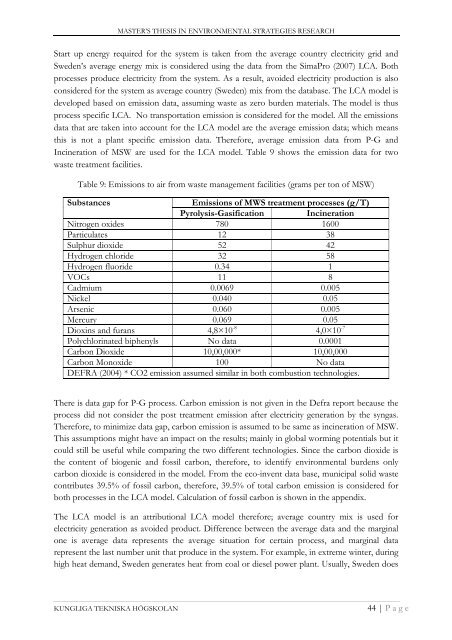Technical Development of Waste Sector in Sweden: Survey
Technical Development of Waste Sector in Sweden: Survey
Technical Development of Waste Sector in Sweden: Survey
Create successful ePaper yourself
Turn your PDF publications into a flip-book with our unique Google optimized e-Paper software.
MASTER’S THESIS IN ENVIRONMENTAL STRATEGIES RESEARCH<br />
Start up energy required for the system is taken from the average country electricity grid and<br />
<strong>Sweden</strong>’s average energy mix is considered us<strong>in</strong>g the data from the SimaPro (2007) LCA. Both<br />
processes produce electricity from the system. As a result, avoided electricity production is also<br />
considered for the system as average country (<strong>Sweden</strong>) mix from the database. The LCA model is<br />
developed based on emission data, assum<strong>in</strong>g waste as zero burden materials. The model is thus<br />
process specific LCA. No transportation emission is considered for the model. All the emissions<br />
data that are taken <strong>in</strong>to account for the LCA model are the average emission data; which means<br />
this is not a plant specific emission data. Therefore, average emission data from P-G and<br />
Inc<strong>in</strong>eration <strong>of</strong> MSW are used for the LCA model. Table 9 shows the emission data for two<br />
waste treatment facilities.<br />
Table 9: Emissions to air from waste management facilities (grams per ton <strong>of</strong> MSW)<br />
Substances<br />
Emissions <strong>of</strong> MWS treatment processes (g/T)<br />
Pyrolysis-Gasification Inc<strong>in</strong>eration<br />
Nitrogen oxides 780 1600<br />
Particulates 12 38<br />
Sulphur dioxide 52 42<br />
Hydrogen chloride 32 58<br />
Hydrogen fluoride 0.34 1<br />
VOCs 11 8<br />
Cadmium 0.0069 0.005<br />
Nickel 0.040 0.05<br />
Arsenic 0.060 0.005<br />
Mercury 0.069 0.05<br />
Diox<strong>in</strong>s and furans 4,8×10 -8 4,0×10 -7<br />
Polychlor<strong>in</strong>ated biphenyls No data 0.0001<br />
Carbon Dioxide 10,00,000* 10,00,000<br />
Carbon Monoxide 100 No data<br />
DEFRA (2004) * CO2 emission assumed similar <strong>in</strong> both combustion technologies.<br />
There is data gap for P-G process. Carbon emission is not given <strong>in</strong> the Defra report because the<br />
process did not consider the post treatment emission after electricity generation by the syngas.<br />
Therefore, to m<strong>in</strong>imize data gap, carbon emission is assumed to be same as <strong>in</strong>c<strong>in</strong>eration <strong>of</strong> MSW.<br />
This assumptions might have an impact on the results; ma<strong>in</strong>ly <strong>in</strong> global worm<strong>in</strong>g potentials but it<br />
could still be useful while compar<strong>in</strong>g the two different technologies. S<strong>in</strong>ce the carbon dioxide is<br />
the content <strong>of</strong> biogenic and fossil carbon, therefore, to identify environmental burdens only<br />
carbon dioxide is considered <strong>in</strong> the model. From the eco-<strong>in</strong>vent data base, municipal solid waste<br />
contributes 39.5% <strong>of</strong> fossil carbon, therefore, 39.5% <strong>of</strong> total carbon emission is considered for<br />
both processes <strong>in</strong> the LCA model. Calculation <strong>of</strong> fossil carbon is shown <strong>in</strong> the appendix.<br />
The LCA model is an attributional LCA model therefore; average country mix is used for<br />
electricity generation as avoided product. Difference between the average data and the marg<strong>in</strong>al<br />
one is average data represents the average situation for certa<strong>in</strong> process, and marg<strong>in</strong>al data<br />
represent the last number unit that produce <strong>in</strong> the system. For example, <strong>in</strong> extreme w<strong>in</strong>ter, dur<strong>in</strong>g<br />
high heat demand, <strong>Sweden</strong> generates heat from coal or diesel power plant. Usually, <strong>Sweden</strong> does<br />
KUNGLIGA TEKNISKA HÖGSKOLAN<br />
44 | Page
















